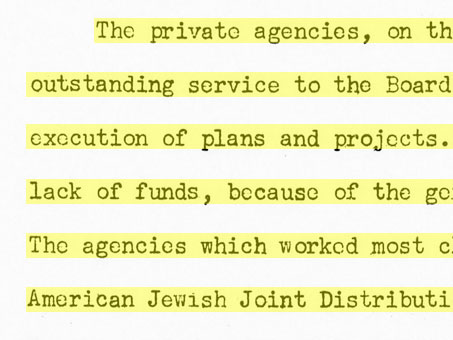
JDC and the War Refugee Board
Rebecca Erbelding, an archivist and curator at the United States Holocaust Memorial Museum (USHMM), recently defended her doctoral dissertation, “About Time: The History of the War Refugee Board.”
The War Refugee Board (WRB), established by an Executive Order from President Franklin D. Roosevelt on January 22, 1944, represented the U.S. official response to the issue of providing relief and rescue to Nazi victims during World War II (WWII). Erbelding researched sources from repositories in Washington, D.C.; Austin, Texas; Hyde Park, NY—and at JDC.
Excerpt from the Final Summary Report of the Executive Director, War Refugee Board.
September 15, 1945.
What is the JDC connection? JDC served as the WRB’s primary funder, providing almost $15 million towards its relief and rescue work until the Board’s dissolution on September 15, 1945.
Erbelding notes that her research seeks to contests a “dominant narrative of American indifference” and “convey[s] how prospects for rescue change as the war progresses.”
In 1943, a year and a half after the U.S. entered WWII, Roosevelt was under pressure from the public, governmental officials, and Jewish organizations such as JDC and the World Jewish Congress to save European Jews. In November 1943, Congress debated the “Rescue Resolution,” a non-binding resolution enjoining Roosevelt to create a government agency to rescue Nazi victims.
The Roosevelt administration was split over the refugee issue. The Treasury Department had approved licenses for some relief organizations to transfer funds from the United States to send aid to Nazi victims in neutral countries. However, the State Department blocked these efforts to facilitate the work of relief agencies. Additionally, Treasury staff learned that State officials had suppressed information about Nazi crimes.
By the end of 1943, Treasury staff brought these findings to Treasury Secretary Henry Morgenthau, Jr.—whose father, Henry Morgenthau, Sr. sent “JDC’s founding telegram” in August 1914 to Jacob Schiff. Morgenthau presented these allegations to the President on January 16, 1944.
Six days later, Roosevelt issued an Executive Order creating the War Refugee Board and charging it “to take all measures within its power to rescue the victims of enemy oppression who are in imminent danger of death.”
In January 1944, JDC Secretary Moses Leavitt traveled to Washington to apprise WRB staff about the dire situation. Leavitt directed JDC aid from the U.S. to German-occupied Europe.
The WRB worked to rescue Nazi victims, deliver supplies, and transport refugees to havens in North Africa, Palestine, and Switzerland, among other locations. Its work was carried out by staff in Washington, representatives in U.S. embassies in neutral and Allied countries, and contacts in the International Red Cross Committee, the United Nations, and other organizations.
In the War Refugee Board’s work, which also included representatives of the Quakers, labor unions, the World Jewish Congress, and the Va’ad Hatzala, JDC stood out as the “trusted relief agency,” Erbelding says, as it conducted “wholesale rescue” and was “easy to work with, discreet, had lots of contacts and a great reputation.”
In spring 1946, several months after the War Refugee Board was closed by Executive Order, it produced a 300-page report of its activities. Thirty-seven copies of this report were disseminated to Treasury, State, and former WRB staff. Moses Leavitt, who went on to serve as JDC’s Executive Vice-Chairman from 1947-1965, was the only private individual to receive a copy of this report.


